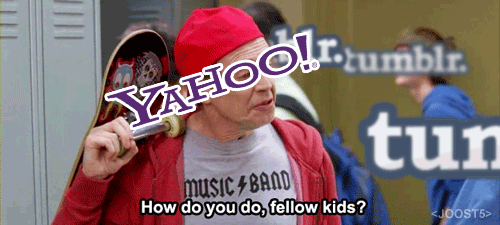The Internet turned 25 a few months ago. But I actually want to talk about something older — ok, maybe not much older, but still.
I want to talk about the GIF. Yes, that funny little file format that’s seen a huge resurgence in the past few years, especially with the popularity of platforms like Tumblr, Reddit, and Giphy. Not to mention the hundreds of mobile apps that let you send, modify, and create GIFs on the go.
Add in sites like 9GAG, Gawker, and Deadspin to the mix, and we’re talking about some serious GIF over-saturation these days. I mean, they’re everywhere — in advertising, journalism, the art world, in what feels like half of all my Twitter conversations nowadays where the “reaction GIF” is king, and even (unsurprisingly) in porn.
As one recent article put it: “The GIF makes absolute sense for porn: The best moments are on repeat forever and ever, or at least until the browser window is closed. Consumers don’t have the time nor the energy for, sigh, a five-minute porn video. A GIF is all killer, no filler, and quick enough that your pizza won’t get cold.”
“All killer, no filler”
Even this quote’s tone is SO like a GIF. It too is “all killer,” cutting right to the point: GIFs, like the Internet itself, feed our baser instincts for speed, repetition, and hyper-consumption. In this way, they’re like every other mass media before them. But in this age of texts instead of phone calls, Instagrams instead of family photo albums, and Upworthy headlines to share without even watching the entire video, the GIF is perfect vernacular.
Anyone following the current World Cup can attest to the sheer amount of GIFs used to instantly communicate every goal. There was even a brief experiment called #GifCup that endlessly repeated all of the most thrilling moments from the games with fullscreen GIFs until FIFA forced them to shut it down. Why watch an entire game when you can GIF-out to all the best highlights?

Some even wonder if GIFs represent an emergent pictorial language. And if you’ve ever seen John McWhorter’s excellent TED Talk, “Txtng is killing language. JK!!!,” you know at least not to fear this, if it’s true. That language is always a product of change — just ask my 70 year-old dad who says things like “totes.” He was born in 1944. And English is his second language.
Talking about age, let’s get back to that. The GIF is now 26 years old. Let that sink in. It was created in 1987, before the Internet — the thing that would give it a reason to live, and sustain it. And as someone who’s just turned 26 myself, I have a theory about the GIF, and about us so-called “Millennials.” Here goes.
We are Generation GIF.
I can think of nothing that represents Millennials better than the GIF, and specifically the animated GIF. Not even the Internet, itself, or anything else on it, can do a better job of representing those of us who were actually born before the web, but who still completely grew up on it (and in many ways are still growing up on it) throughout almost all of its stages — from AOL dial tones to Justin Timberlake asking what’s cooler than a million dollars.
Nothing but the GIF.
That’s especially true for the mobile web era we’re in now, where content is getting smaller, shorter, and more viral to the point that (I kid you not) there’s literally someone who works at Deadspin who has 10 computer monitors set up to follow up to 28 sporting events at once, all to satisfy their audience’s hunger for the animated GIFs he creates. We’re in a constant viral environment, where even the novelty of “going viral” has worn off.
How did we get here?
Well, let’s look at ourselves in the mirror a little bit.
The narrative of how the GIF has grown and emerged into maturity fits with the trajectory of our own Millennial lives. I vividly remember building GIF heavy websites as a kid (remember those “Under Construction: Come Back Soon” ones?) devoted to things like video games and movies, loading them onto floppies to show off at school. Now sites like 9GAG, Gawker, and BuzzFeed have built multi-million dollar businesses off of essentially the same impulse: social sharing.
YTMND
It’s the same reason I remember being so enamored with a site called YTMND in High School — a feeling of community organized around a single bit of content endlessly repeated and then remixed into memes.
Founded with the creation of yourethemannowdog.com, a meta site that’s just Sean Connery yelling “You’re the man now, dog!” over and over (and over) again taken from the film Finding Forrester, it’s an early prototype for many of the sites and services that are viral hits today.
Allowing users to create their own similarly looping sites, many of which prominently displayed GIFs, you can now find echoes of YTMND today in everything from Vine videos (with their 6 seconds of looping content and increasingly meta community) to spoof Twitter accounts, Tumblr GIF blogs, contemporary advertising that leverages heavily upon platforms like YouTube, and everything and anything else that perhaps can fall under the general term of “content marketing.”
This is the era of content that we’re now defining, with Millennials (and more specifically, with Generation GIF) not only entering the workforce, but quickly ascending to leadership positions, and in some high-profile Cinderella tales, creating or helping to create multi-million, even multi-billion dollar companies. As Business Insider and CBS News report, there’s a palpable ageism that comes along with the biggest tech companies around: “Mark Zuckerberg is 28. Tumblr’s David Karp is only 27, and the founders of DropBox are 27 and 30,” all while “the median ages of employees at Apple, Google and Facebook are 33, 31 and 26, respectively.”
How do you do, fellow kids?
When Yahoo purchased Tumblr last year, one of the most popular things shared on Tumblr about the news was this GIF. It was far more prevalent on the site, for instance, than Yahoo’s own GIF about the acquisition.
The GIF is now 26 years young, but old enough to know that it’s definitely cooler than a 20 year-old company like Yahoo, that’s for sure.
The GIF was born in the 80s and it’s proud of that, but it’s also all about the future — it’s about what’s next. It’s about the latest fake concept for the next iPhone on Dribbble. It’s about the next season of House of Cards, even (and especially) if the new season has already been released. It’s about binge-watching.
It’s about endless replay value. It’s about us.
No matter how much longer the GIF is used, no matter how or by what or when it’s replaced, it’s already left its mark upon an entire generation that just wants to show you that new funny thing they’ve found online.








